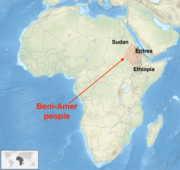Beni-Amer people
| Total population | |
|---|---|
| (~0.3 million) | |
| Regions with significant populations | |
|
| |
| Languages | |
| Beja language | |
| Religion | |
| Islam | |
| Related ethnic groups | |
| Beja people, Tigre people |
The Beni-Amer, also known as Beni-Amir, sometimes simply as Amer or Nabtab, are a northeast African ethnic group.[1] They are a subgroup of the Beja people who inhabit eastern Sudan, Eritrea and northwestern Ethiopia.[1][2] They are Muslim and constitute the largest tribal confederation in Eritrea.[3]
Demographics and distribution
Some 300,000 people in northeastern Africa belong to the Beni-Amer ethnic group. They live near the Red Sea around the borders of Eritrea, Sudan and Ethiopia.[1][2]
The Beni-Amer people probably emerged in the fourteenth century AD from the intermixing of the Beja and the Tigre. They are likely Hamitic, a mix of Abyssinians and Nubians. The Beni-Amer occupy the borders between much of Eritrea's Barka valley, Port Sudan Tokar, Aqiq, and the Kassala areas of eastern Sudan. They speak Beja and Tigre, both of which belong to the Afro-Asiatic family.[4]
History

The Beni-Amer people became politically significant in the 16th-century when their founder Amer Kunu – the son of a Muslim holy man named Ali Nabit[5] – joined forces with the Funj and the Ja'alin to defeat the Belew rulers of Eritrea and the surrounding region. Amer's descendants, or Beni-Amer in Arabic, became the new ruling class called Nabtabs who allied themselves with Diglal as the paramount chief ruler.[3][6] A confederation of many subtribes accepted the new rule, and these therefrom have been the Beni-Amer people.[3][7]
The Beni Amer remained aligned to the Funj, and paid annual tribute to them until 1821. They became a party to the Italian colonialism when they partnered with the Italians to defeat the Sudanese Mahdiyya in the 1880s. During World War II, the Beni Amer ruling class supported the Italians. The defeat of Italy led to a regional power shake up and reduction in the military powers of the Beni Amer.[8]
Social stratification
The Beni Amer people have a highly stratified social structure.[2][3] At the top is the elite ruling caste who call themselves as the "true Beni Amer" (or true descendants of Amer) or Nabtab, they have controlled the economic and political decisions, and they constitute about 10% of their total population.[2][6][3] The others are considered subservient and referred to as Hedarab, Hadendowa, or Tigre by the Nabtabs.[2] The subservient group have been serfs to the Beni Amer clan units, and they have been further subdivided into lineages.[2][3] Major subdivisions of Tigre were occupationally isolated, such as the Almada and Asfada could produce and supply milk, but Hamasein, Abhasheila and Wilinnoho were not allowed to.[7] The Nabtabs also levied taxes and collected periodic tributes from his serfs.[7]
According to Paul, ever since Amer Kunu came to power, intermarriage between Nabtab and Tigre castes were forbidden and the caste distinctions were strictly enforced.[5] This was successfully accomplished by the small elite, states Paul, through the "force of arms".[9]
Livelihood
They lead a tribal pastoral life, with those in the northern territories raising camels, and the southerners raising cattle. In contemporary era, many have adopted a farming lifestyle and become migrant wage labor providers.[2]
References
- 1 2 3 Anthony Appiah; Henry Louis Gates (2010). Encyclopedia of Africa. Oxford University Press. p. 167. ISBN 978-0-19-533770-9.
- 1 2 3 4 5 6 7 James Stuart Olson (1996). The Peoples of Africa: An Ethnohistorical Dictionary. Greenwood. pp. 89–90. ISBN 978-0-313-27918-8.
- 1 2 3 4 5 6 Dan Connell; Tom Killion (2010). Historical Dictionary of Eritrea. Scarecrow. pp. 119, 121–122, 280. ISBN 978-0-8108-7505-0.
- ↑ Anthony Appiah; Henry Louis Gates (2010). Encyclopedia of Africa. Oxford University Press. pp. 162, 167. ISBN 978-0-19-533770-9.
- 1 2 A. Paul (2012). A History of the Beja Tribes of the Sudan. Cambridge University Press. pp. 82–83. ISBN 978-1-107-64686-5.
- 1 2 SH Longrigg (2012), “Diglal”, in Encyclopaedia of Islam, Second Edition, Editors: P. Bearman et al, BRILL Academic, ISBN 978-9004161214, Quote: "Diglal. The title of the hereditary ruler of the Banī ʿĀmir tribal group in the Agordat district of western Eritrea and in the eastern Sudan; he is also senior member of the aristocratic Nabtab class or caste."
- 1 2 3 A. Paul (2012). A History of the Beja Tribes of the Sudan. Cambridge University Press. pp. 86–88. ISBN 978-1-107-64686-5.
- ↑ Dan Connell; Tom Killion (2010). Historical Dictionary of Eritrea. Scarecrow. pp. 122–123. ISBN 978-0-8108-7505-0.
- ↑ A. Paul (2012). A History of the Beja Tribes of the Sudan. Cambridge University Press. pp. 83–84, 86. ISBN 978-1-107-64686-5.
Bibliography
- Anglo-Egyptian Sudan, ed. Count Gleichen (London, 1905);
- A. H. Keane, Ethnology of Egyptian Sudan (1884);
Further reading
![]() Chisholm, Hugh, ed. (1911). "Beni-Amer". Encyclopædia Britannica. 3 (11th ed.). Cambridge University Press. p. 737.
Chisholm, Hugh, ed. (1911). "Beni-Amer". Encyclopædia Britannica. 3 (11th ed.). Cambridge University Press. p. 737.